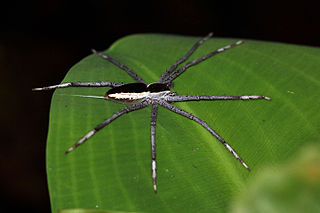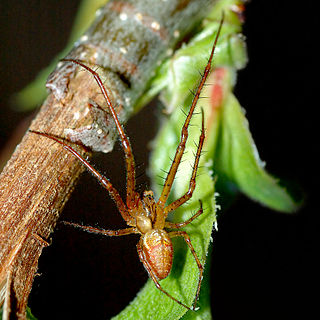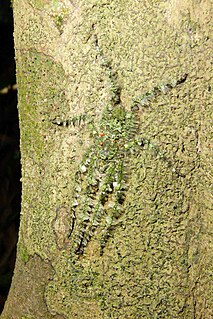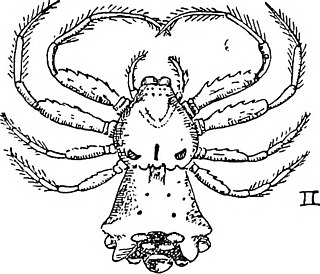
Nursery web spiders (Pisauridae) is a family of araneomorph spiders first described by Eugène Simon in 1890. They resemble wolf spiders (Lycosidae) except for several key differences. Wolf spiders have two very prominent eyes in addition to the other six, while a nursery web spider's eyes are all about the same size. Additionally, female nursery web spiders carry their egg sacs with their jaws and pedipalps instead of attaching them to their spinnerets as wolf spiders do. When the eggs are about to hatch, a female spider builds a nursery "tent", places her egg sac inside, and stands guard outside, hence the family's common name. Like the wolf spiders, however, the nursery web spiders are roaming hunters that don't use webs for catching prey. They have a wide variety of prey, and larger species may prey upon vertebrates, particularly amphibians and fish.

Orb-weaver spiders or araneids are members of the spider family Araneidae. They are the most common group of builders of spiral wheel-shaped webs often found in gardens, fields and forest. "Orb" can in English mean "circular", hence the English name of the group. Araneids have eight similar eyes, hairy or spiny legs, and no stridulating organs.

Long-jawed orb weavers or long jawed spiders (Tetragnathidae) is a family of araneomorph spiders first described by Anton Menge in 1866. They have elongated bodies, legs, and chelicerae, and build small orb webs with an open hub with few, wide-set radii and spirals with no signal line or retreat. Some species are often found in long vegetation near water.
Colyttus is a genus of Asian jumping spiders that was first described by Tamerlan Thorell in 1891. It is named for the Latin word for "with two stripes". C. lehtinen is named in honor of Finnish arachnologist Pekka T. Lehtinen.

Hyllus is a genus of the spider family Salticidae.

Plexippus is a genus of jumping spiders that was first described by Carl Ludwig Koch in 1846. It is considered a senior synonym of Hissarinus and Apamamia.

Telamonia is a genus of jumping spiders that was first described by Tamerlan Thorell in 1887. They are colorful spiders, with patterns that vary considerably between sexes and species. Two longitudinal stripes along the abdomen are common, and the carapace is often colored. They have a slender opisthosoma and long legs.

Thiania is a genus of jumping spiders that was first described by Carl Ludwig Koch in 1846.

Diaea is a genus of crab spiders first described by Tamerlan Thorell in 1869. Most species are found in specific locations except for D. livens, which occurs both in the United States and D. dorsata, which has a palearctic distribution. Adults are 5 millimetres (0.20 in) to 7 millimetres (0.28 in) and tend to hide in and around vegetation, especially flowers, where their color allows them to blend in to their surroundings.
Ordgarius is a genus of orb-weaver spiders first described by Eugen von Keyserling in 1886.
Pherenice is a genus of Central African orb-weaver spiders containing the single species, Pherenice tristis. It was first described by Tamerlan Thorell in 1899, and has only been found in Cameroon.

Cyrtarachne is a genus of orb-weaver spiders first described by Tamerlan Thorell in 1868.

Pandercetes is a genus of huntsman spiders that was first described by Ludwig Carl Christian Koch in his 1875 treatise on Australian spiders. They are mainly distributed in tropical Asia and Australia, and are known for their cryptic coloration that matches local moss and lichen. Their legs have lateral hairs, giving them a feathery appearance, further masking their outline against tree trunks. Their head is somewhat elevated and the carapace has the thoracic region low and flat.

Phrynarachne is a genus of crab spiders first described by Tamerlan Thorell in 1869.
Procopius is a genus of African corinnid sac spiders first described by Tamerlan Thorell in 1899.

Boliscus is a genus of Asian crab spiders first described by Tamerlan Thorell in 1891. As of February 2019 it contains only three species.
Creugas is a genus of corinnid sac spiders first described by Tamerlan Thorell in 1878.
Milonia is a genus of Southeast Asian orb-weaver spiders first described by Tamerlan Thorell in 1890.
Charminus is a genus of nursery web spiders that was first described by Tamerlan Thorell in 1899.
Ammonius pupulus is a species of Central African brushed trapdoor spiders. It is the only species in the genus Ammonius . It was first described by Tamerlan Thorell in 1899, and has only been found in Cameroon.











